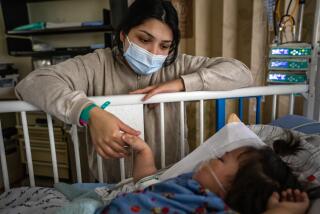ORANGE : Germ-Filtered Room Protects Little Boy
- Share via
Some of the biggest threats to Alex Brown’s life are microscopic.
Germs, bacteria, fungi--all are tiny killers to 23-month-old Alex, whose immune system is vulnerable after a bone marrow transplant that doctors hope will help cure neuroblastoma, a pervasive form of nerve cell cancer.
Since the transplant a little more than a month ago, Alex has little ability to fight infection, “the No. 1 killer of transplant patients,” according to his doctor at Children’s Hospital of Orange County.
Alex endured surgery and intensive chemotherapy to purge the cancer but seemed particularly vulnerable to infection and suffered many setbacks. For young patients such as Alex, four new state-of-the-art laminar flow rooms at CHOC offer the best chance for recovery, experts at the hospital say.
The modular rooms, installed as complete units in November for $500,000 each, are the only ones for children in the county. Alex is the fourth youngster to use one of them since the rooms opened to patients in late March.
Simple in concept, Alex’s room literally blow germs away from his crib, where he sleeps wrapped in a teddy bear blanket. One wall of the room is constructed of metal panels, each containing dozens of small holes.
Behind the panels, air blows through filters at a rate of three to six miles an hour and becomes 99.9% particle free, said Rita Secola, an oncology clinical nurse specialist who helped train hospital staff how to use the special rooms.
“The filters are so minute that any organism that can cause infections, it will take care of them,” Secola said.
The constant blowing completely replaces the air in the room about once a minute, Secola said. The room has no door, and the airflow creates an effective barrier to keep germs out.
To keep conditions in the room as germ-free as possible, there is also a special water-sterilization unit and there is no toilet. All of Alex’s toys, books, blankets and other supplies are sterilized before being allowed in the room.
Visits by relatives are restricted. Nurses enter his room just once a day and anyone entering the room first must suit up in a hospital gown, mask, shoes and gloves. He is allowed no skin-to-skin contact.
Even Alex’s doctor, Geni A. Bennetts, director of CHOC’s Hematology and Oncology unit, rarely enters his room. She examines him through a specially designed plastic curtain that creates a second “wall” of the room.
Research on the rooms’ effectiveness is limited and incomplete, Bennetts said. To some, the treatment may seem extreme and the lack of human contact psychologically damaging. But Bennetts was so convinced that the laminar flow rooms could help her patients that she spent five years lobbying for them.
“One hundred years from now, this technology may look barbaric or archaic but right now it’s the best we know,” Bennetts said.
Alex’s mother, Gerri Brown, 27, is allowed to hold her son, but she admits that it’s hard not to be able to touch his small face to hers. Still, she believes the process is worth it.
“This is one extra step that you can take,” she said. “If you can have that extra inch, why not take it?”
More to Read
Sign up for Essential California
The most important California stories and recommendations in your inbox every morning.
You may occasionally receive promotional content from the Los Angeles Times.













